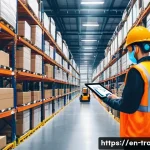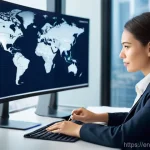Alright, let’s dive right into dissecting past International Trade Specialist Exam questions, shall we? From my own experience prepping for similar certifications, the real trick isn’t just memorizing terms, but understanding the *why* behind each regulation and trade practice.
You know, like actually picturing goods flowing across borders and the paperwork nightmare that can ensue! The recent buzz around supply chain disruptions and tariff wars definitely makes this subject feel a whole lot more relevant than some dusty textbook.
Plus, future trade agreements are going to be heavily influenced by current geopolitical tensions, so nailing these fundamentals is crucial. So, how can we best prepare for this exam?
Let’s explore this topic in greater detail below.
Alright, let’s dive right into dissecting past International Trade Specialist Exam questions, shall we? From my own experience prepping for similar certifications, the real trick isn’t just memorizing terms, but understanding the *why* behind each regulation and trade practice.
You know, like actually picturing goods flowing across borders and the paperwork nightmare that can ensue! The recent buzz around supply chain disruptions and tariff wars definitely makes this subject feel a whole lot more relevant than some dusty textbook.
Plus, future trade agreements are going to be heavily influenced by current geopolitical tensions, so nailing these fundamentals is crucial. So, how can we best prepare for this exam?
Let’s explore this topic in greater detail below.
Decoding Incoterms: Beyond the Acronyms

Incoterms (International Commercial Terms) are basically the universal language of trade. But just rattling off “FOB,” “CIF,” or “DDP” won’t cut it on the exam. You need to understand the nitty-gritty: who’s responsible for what at each stage of the shipping process, and when does the risk of loss or damage transfer? I remember one particularly tricky question that involved a shipment of avocados from Mexico to Canada. The buyer and seller had agreed on “CIF Toronto,” but the avocados rotted during transit due to improper refrigeration. The exam question asked who was liable for the loss. Knowing that CIF means the seller is responsible for the cost, insurance, and freight to the named port of destination, but the risk transfers to the buyer once the goods are loaded on board the ship in Mexico, was key to answering correctly. So really dig deep and ensure you grasp these concepts thoroughly. Think about real-world scenarios; it will stick better than rote memorization. Also, keep an eye on the latest Incoterms revisions! The International Chamber of Commerce (ICC) updates them periodically to reflect changes in trade practices and technology.
1. Risk Transfer Pitfalls
Pay close attention to the exact point at which risk transfers from the seller to the buyer. It’s not always intuitive. Sometimes, even if the seller is paying for the freight, the risk shifts much earlier in the process. For example, with “FOB (Free On Board) named port,” the risk transfers when the goods are loaded onto the ship at the port of origin, even though the seller might be paying for the shipping all the way to the buyer’s destination. This has massive implications for insurance and liability.
2. Cost Allocation Comprehension
Understand precisely which costs each party is responsible for under each Incoterm. This goes beyond just freight and insurance. Consider costs like customs clearance, duties, taxes, terminal handling charges, and even the cost of providing proof of delivery. A seemingly small detail about who pays for unloading charges at the destination port can be the difference between a correct and incorrect answer on the exam.
Mastering Customs Valuation: It’s All About the Transaction Value
Customs valuation is another exam staple, and it’s often more complex than it seems. The primary method of customs valuation is based on the transaction value of the goods – the price actually paid or payable for the goods when sold for export to the country of importation. Sounds simple, right? But there are numerous adjustments that can be made to the transaction value, such as adding back certain costs that weren’t included in the original invoice price, or deducting certain discounts that weren’t properly documented. For example, let’s say you’re importing a shipment of smartphones from China to the US. The invoice price is $100 per phone, but you also paid a separate fee for engineering work done in the US to customize the phones for the American market. That engineering fee might need to be added back to the customs value, even though it wasn’t part of the per-phone price. On the flip side, if you received a volume discount that wasn’t reflected on the invoice, you might be able to deduct it, but you’ll need proper documentation to support the deduction.
1. Dutiable Additions
Be aware of all the potential additions to the transaction value. These can include things like packing costs, commissions, royalties, license fees, and the value of any assists (materials, components, tools, etc.) that the buyer provided to the seller free of charge or at a reduced cost. Overlooking any of these additions can lead to an undervaluation of the goods and potential penalties from customs authorities.
2. Acceptable Deductions
Understand which deductions from the transaction value are allowed, and what documentation is required to support them. Common deductions include discounts, rebates, and transportation costs incurred after importation. However, customs authorities will scrutinize these deductions closely, so make sure you have solid evidence to back them up. I’ve seen firsthand how a lack of proper documentation can lead to hefty fines.
Navigating Trade Agreements: More Than Just Reduced Tariffs
Trade agreements (like NAFTA/USMCA, the EU-Canada Comprehensive Economic and Trade Agreement (CETA), and the Comprehensive and Progressive Agreement for Trans-Pacific Partnership (CPTPP)) are key to understanding global trade flows. But it’s not just about tariff reductions. These agreements often include provisions on intellectual property rights, investment protection, labor standards, and environmental regulations. They also establish rules of origin, which determine whether goods qualify for preferential tariff treatment under the agreement. For instance, if you’re importing a car from Mexico into the US under the USMCA, you need to be able to prove that the car meets the agreement’s rules of origin – typically a certain percentage of the car’s components must have originated in North America. Failing to meet these rules can mean paying the full non-agreement tariff rate, which can significantly impact your bottom line. Also, trade agreements are constantly evolving, so stay updated on any recent changes or amendments.
1. Rules of Origin Complexity
Mastering the rules of origin is crucial. These rules can be incredibly complex and vary widely from agreement to agreement and product to product. Understanding the different types of rules of origin (e.g., wholly obtained, substantial transformation, regional value content) and how to apply them is essential for maximizing the benefits of trade agreements.
2. Non-Tariff Barriers
Don’t overlook the non-tariff barriers to trade that are often addressed in trade agreements. These can include things like sanitary and phytosanitary (SPS) measures, technical regulations, and conformity assessment procedures. These barriers can be just as restrictive as tariffs, and understanding how they are addressed in trade agreements is important for ensuring smooth trade flows. Think about food safety standards, for example. A trade agreement might include provisions on harmonizing food safety regulations between countries, which can reduce the burden on exporters.
Understanding Export Controls: It’s About National Security and More
Export controls aren’t just about preventing sensitive technologies from falling into the wrong hands. They also cover a wide range of other concerns, such as protecting human rights, enforcing economic sanctions, and preventing the proliferation of weapons of mass destruction. In the US, for example, the Export Administration Regulations (EAR) govern the export and re-export of most commercial items, while the International Traffic in Arms Regulations (ITAR) control the export of defense articles and services. Violating these regulations can lead to severe penalties, including fines, imprisonment, and the loss of export privileges. I remember a case where a company was fined millions of dollars for exporting computer software to Iran without the proper licenses, even though the company claimed it didn’t know the software was subject to export controls. Ignorance of the law is no excuse! Do you know what is and is not allowed?Here’s a quick summary of why Export Controls are important:
| Control Type | Description | Example Enforcement Agency (USA) |
|---|---|---|
| National Security | Preventing the export of goods/technologies that could harm national security. | Bureau of Industry and Security (BIS) |
| Economic Sanctions | Enforcing trade restrictions against specific countries or entities. | Office of Foreign Assets Control (OFAC) |
| Human Rights | Restricting exports that could contribute to human rights abuses. | Department of State |
1. Know Your Customer and End-Use
Export control regulations require you to know who you’re selling to and what they’re going to do with the goods. This means conducting due diligence to screen your customers against denied parties lists, and assessing the potential end-uses of your products. If you have any doubts about the legitimacy of a transaction, you should err on the side of caution and seek guidance from export control experts.
2. Licensing Requirements and Exceptions
Understand the licensing requirements for your products and destinations. Some items may require a license for export to certain countries, while others may be eligible for license exceptions. Carefully review the applicable regulations and determine whether a license is needed. If you’re unsure, it’s always best to apply for a license to avoid potential violations.
Financing International Trade: Letters of Credit and Beyond
Financing international trade is a complex area that involves a variety of instruments and techniques. Letters of credit (L/Cs) are a classic method of payment in international trade, providing a secure way for buyers and sellers to transact business across borders. But L/Cs are not the only option. Other financing methods include documentary collections, open account terms, and export credit insurance. The choice of financing method depends on a variety of factors, such as the creditworthiness of the buyer, the riskiness of the transaction, and the prevailing market conditions. For example, if you’re selling goods to a new customer in a high-risk country, you might insist on using an L/C to protect yourself against non-payment. On the other hand, if you have a long-standing relationship with a reliable customer, you might be willing to offer open account terms to build goodwill and increase sales.
1. Understanding Letter of Credit Mechanics
Master the mechanics of letters of credit, including the roles of the applicant, beneficiary, issuing bank, confirming bank, and advising bank. Understand the different types of L/Cs (e.g., revocable, irrevocable, confirmed, unconfirmed) and the steps involved in presenting documents and receiving payment. A common exam question might involve a discrepancy in the documents presented under an L/C, and you’ll need to know whether the bank is justified in refusing payment.
2. Exploring Alternative Financing Options
Familiarize yourself with alternative trade finance options, such as documentary collections, open account terms, and export credit insurance. Understand the advantages and disadvantages of each option, and when they are most appropriate to use. Export credit insurance, for example, can provide protection against non-payment by foreign buyers, which can be particularly useful when dealing with customers in emerging markets.
Intellectual Property Rights: Protecting Your Brand and Innovations
Intellectual property rights (IPR) are crucial for protecting your brand and innovations in the global marketplace. This includes trademarks, patents, copyrights, and trade secrets. Infringement of IPR can lead to significant financial losses and damage to your reputation. It’s essential to register your trademarks and patents in the countries where you do business, and to actively monitor the market for counterfeit goods and other IPR violations. In addition, many countries have laws that prohibit the import of goods that infringe on IPR, so you need to be aware of these laws and take steps to ensure that your products do not infringe on the IPR of others. For example, if you’re selling clothing with a logo that is similar to a registered trademark, you could be sued for trademark infringement and have your goods seized by customs authorities. It’s very important to take appropriate precautions to avoid IPR issues.
1. Trademark and Patent Registration Strategies
Develop a comprehensive strategy for registering your trademarks and patents in key markets. This involves conducting searches to ensure that your marks and inventions are not already protected by others, and filing applications with the relevant intellectual property offices. Consider using the Madrid System for International Registration of Marks to simplify the process of registering trademarks in multiple countries.
2. Combating Counterfeiting and Piracy
Implement measures to combat counterfeiting and piracy of your products. This can include working with customs authorities to identify and seize counterfeit goods, conducting online monitoring to detect and remove infringing listings, and taking legal action against infringers. Remember, a proactive approach to IPR protection is essential for maintaining your competitive advantage in the global marketplace.
Wrapping Up
Navigating the complexities of international trade can seem daunting, but with a solid grasp of these key areas – Incoterms, customs valuation, trade agreements, export controls, and trade finance – you’ll be well-prepared to tackle the International Trade Specialist Exam. Remember to focus on real-world application and stay updated on the latest developments in the field. Good luck, and may your trade winds always be fair!
Useful Information to Know
1. Incoterms 2020 Updates: Familiarize yourself with the latest Incoterms revisions. The International Chamber of Commerce (ICC) updates these terms periodically to reflect changes in trade practices. Understanding the changes can give you a competitive edge.
2. Harmonized System (HS) Codes: Get comfortable with using HS codes. These standardized codes are used worldwide to classify traded products. Being able to accurately classify goods is essential for determining tariffs, taxes, and trade regulations.
3. Free Trade Agreement Portals: Many countries have online portals that provide information on their free trade agreements. These portals can be a valuable resource for understanding the rules of origin, tariff schedules, and other provisions of the agreements.
4. Denied Parties Lists: Regularly check denied parties lists to ensure that you are not doing business with individuals or entities that are prohibited from engaging in international trade. Government agencies such as the Bureau of Industry and Security (BIS) and the Office of Foreign Assets Control (OFAC) maintain these lists.
5. Trade Finance Webinars and Seminars: Participate in webinars and seminars on trade finance to learn about the latest trends and techniques. Organizations like the International Chamber of Commerce (ICC) and various trade associations offer these educational opportunities.
Key Takeaways
Incoterms: Understand the responsibilities and liabilities of buyers and sellers under each Incoterm.
Customs Valuation: Master the principles of transaction value and the adjustments that can be made to it.
Trade Agreements: Focus on rules of origin and non-tariff barriers.
Export Controls: Know your customer, end-use, and licensing requirements.
Trade Finance: Familiarize yourself with letters of credit and alternative financing options.
Frequently Asked Questions (FAQ) 📖
Q: What’s the single best study strategy for cracking the International Trade Specialist Exam?
A: Honestly, ditch the rote memorization! Instead, focus on understanding the application of trade regulations. Think about real-world scenarios.
For instance, if you’re studying Incoterms, don’t just memorize the definitions; try to visualize a specific product – let’s say, artisanal coffee beans from Colombia – being shipped under each term.
What are the risks and responsibilities for the buyer and seller under CIF versus FOB? Working through practical examples like this will stick with you way more than just reading definitions.
I remember almost failing a practice test until I started picturing actual transactions in my head.
Q: Are there any specific resources or websites you recommend for exam prep?
A: Absolutely! Beyond the official study guides, I found the U.S. Customs and Border Protection (CBP) website invaluable.
They have tons of free resources, including regulations, rulings, and even training materials. Also, check out the International Chamber of Commerce (ICC) website for information on Incoterms and model contracts.
Don’t underestimate the power of online forums either – sites like Reddit’s r/customs are great for asking questions and getting insights from experienced professionals.
I personally benefited from a free online course about export controls from a university in Maryland. I found it particularly helpful to get a deeper understanding of the subject.
Q: How important is it to stay up-to-date on current events in international trade when preparing for the exam?
A: It’s HUGE! Seriously, ignoring current events is like trying to navigate a ship without a compass. Trade agreements, tariff changes, and geopolitical tensions can all have a significant impact on trade regulations and practices.
Read reputable sources like the Wall Street Journal or the Financial Times to stay informed. Pay attention to major trade disputes, like the ongoing trade war between the U.S.
and China, and try to understand the implications for businesses. This isn’t just about answering exam questions; it’s about developing a deeper understanding of the global trade landscape.
For example, recent changes in trade regulations involving semiconductors are going to have a lasting impact on the industry, so understanding the nuances is a must.
📚 References
Wikipedia Encyclopedia
구글 검색 결과
구글 검색 결과
구글 검색 결과
구글 검색 결과
구글 검색 결과






